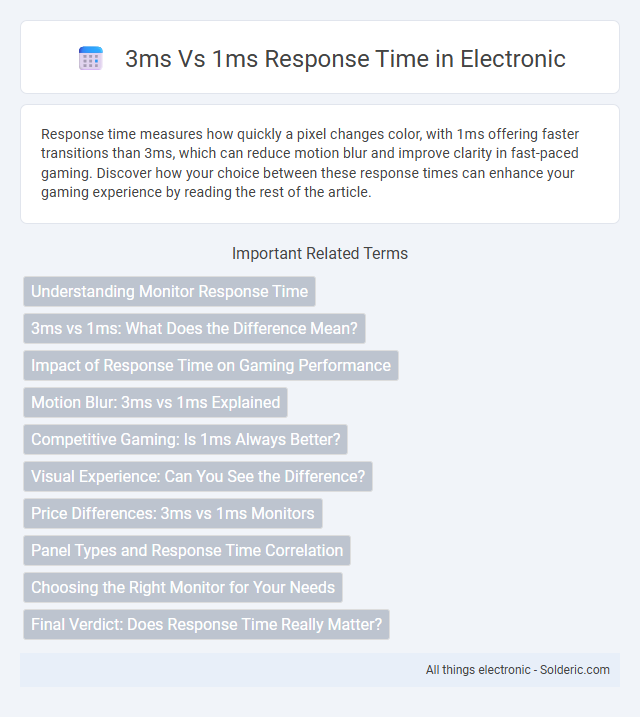Response time measures how quickly a pixel changes color, with 1ms offering faster transitions than 3ms, which can reduce motion blur and improve clarity in fast-paced gaming. Discover how your choice between these response times can enhance your gaming experience by reading the rest of the article.
Comparison Table
| Feature | 3ms Response Time | 1ms Response Time |
|---|---|---|
| Definition | Displays pixel changes in 3 milliseconds | Displays pixel changes in 1 millisecond |
| Input Lag | Higher compared to 1ms, may cause slight delay in fast gaming | Lowest input lag, ideal for competitive gaming |
| Motion Blur | Visible slight motion blur during fast scenes | Minimal to no motion blur, clear fast movement |
| Use Case | Suitable for casual gaming and general use | Best for esports, professional gamers, and fast-paced games |
| Price Range | Generally more affordable | Typically higher cost due to advanced technology |
Understanding Monitor Response Time
Monitor response time measures the speed at which pixels change from one color to another, typically from gray-to-gray or black-to-white, directly impacting motion clarity and reducing blurring during fast-paced scenes. A 1ms response time offers significantly faster pixel transitions compared to a 3ms response time, making it ideal for competitive gaming and high-speed visuals where every millisecond counts. Choosing a monitor with a lower response time enhances visual performance by minimizing ghosting and motion blur, leading to smoother and more immersive viewing experiences.
3ms vs 1ms: What Does the Difference Mean?
The difference between 3ms and 1ms response time primarily affects motion clarity and input lag in gaming and fast-paced visuals. A 1ms response time reduces ghosting and blur more effectively than 3ms, delivering smoother transitions and more precise frames per second (FPS) performance. While 3ms is generally sufficient for most users, professional gamers and competitive environments benefit from the ultra-fast response to enhance reaction times and visual accuracy.
Impact of Response Time on Gaming Performance
A 1ms response time significantly reduces motion blur and ghosting compared to a 3ms response time, enhancing the clarity of fast-moving images in competitive gaming. Lower response times allow for quicker reaction to in-game events, providing a competitive edge especially in fast-paced genres like FPS and racing games. Professional gamers often prefer 1ms monitors to ensure smoother gameplay and improved visual precision, directly influencing performance outcomes.
Motion Blur: 3ms vs 1ms Explained
A 1ms response time significantly reduces motion blur compared to 3ms, resulting in crisper and clearer images during fast-paced scenes or gaming. Lower response times minimize the trailing effect behind moving objects, enhancing visual clarity and overall user experience. While 3ms is adequate for general use, the 1ms response time is preferred for competitive gaming to achieve optimal motion sharpness.
Competitive Gaming: Is 1ms Always Better?
In competitive gaming, a 1ms response time can offer a marginal advantage by reducing input lag and improving screen refresh accuracy, which may enhance reaction speed in fast-paced titles like first-person shooters. However, the practical difference between 1ms and 3ms response times is often negligible due to other factors like monitor refresh rate, system latency, and player skill level. High-refresh-rate displays (144Hz or above) combined with a 3ms response time still provide smooth gameplay, making 1ms response time beneficial but not always a decisive edge in competitive gaming.
Visual Experience: Can You See the Difference?
A 1ms response time minimizes motion blur and ghosting, delivering clearer visuals during fast-paced gaming or action scenes compared to a 3ms response time. While some users may notice sharper transitions and smoother animations at 1ms, the difference can be subtle for everyday tasks or casual viewing. Your visual experience improves most in competitive gaming, where every millisecond influences reaction time and image clarity.
Price Differences: 3ms vs 1ms Monitors
1ms monitors typically come at a higher price point due to advanced panel technology and faster refresh rates, offering superior performance for competitive gaming. 3ms monitors, while slightly slower in response time, provide a more budget-friendly option without significantly compromising visual smoothness for casual users. Your choice will depend on balancing price sensitivity with the need for ultra-fast responsiveness in gaming or professional tasks.
Panel Types and Response Time Correlation
TN (Twisted Nematic) panels typically achieve faster response times around 1ms, making them ideal for competitive gaming where quick pixel transitions reduce motion blur. IPS (In-Plane Switching) panels usually have response times closer to 3ms but offer superior color accuracy and viewing angles, providing a balanced experience for multimedia use. Your choice between 1ms and 3ms response times should consider the panel type's impact on both speed and visual quality to match your specific needs.
Choosing the Right Monitor for Your Needs
When choosing between a 3ms and 1ms response time monitor, consider your primary use case; 1ms response times are ideal for competitive gaming where every millisecond counts, reducing motion blur and ghosting for sharper visuals. A 3ms response time monitor often suffices for casual gaming and everyday tasks, offering a balance between performance and cost. Prioritize monitors with low input lag and high refresh rates alongside response times to ensure optimal performance tailored to your needs.
Final Verdict: Does Response Time Really Matter?
Response time, measured in milliseconds, impacts the fluidity of on-screen motion, with 1ms offering the fastest pixel transition and reduced motion blur compared to 3ms. Competitive gamers and high-speed visuals benefit most from a 1ms response time, providing clearer images during rapid gameplay. For most users, especially in casual gaming or general use, the difference between 3ms and 1ms is negligible, making other factors like refresh rate and input lag more critical.
3ms vs 1ms Response Time Infographic

 solderic.com
solderic.com